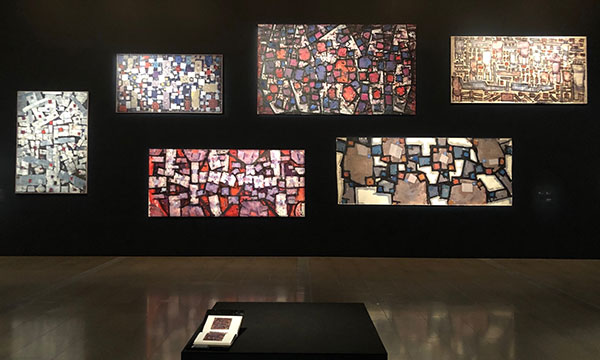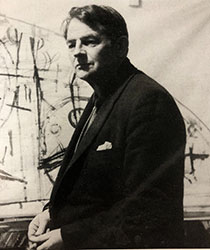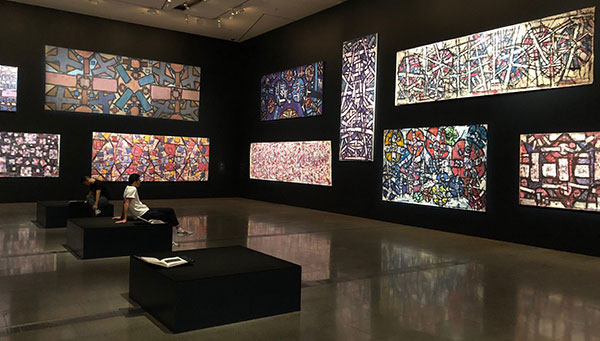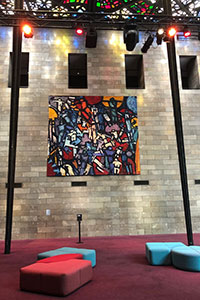 “His glimpses of the ineffable are translated to us in terms of dancing, for his paintings are a choreography of the spirit – but the dancing is never extravagant. It has the formal quality of a saraband. Every movement, every gesture, every brushstroke becomes part of a ritual.”
“His glimpses of the ineffable are translated to us in terms of dancing, for his paintings are a choreography of the spirit – but the dancing is never extravagant. It has the formal quality of a saraband. Every movement, every gesture, every brushstroke becomes part of a ritual.”
James Gleeson, review in Sydney’s Sun, 14 June 1967.
With these evocative words, James Gleeson described the work of Kemp’s maturity, developed in the 1960s. His more figurative work of the 1950s gave way to abstract art, playing with geometric shapes in muted purples and reds, blues and greys. He was not however just concerned with making patterns. He sought to penetrate to the relationships underlying all existence; this was uncommon in Australian art. He may be dubbed a maverick metaphysician.

 After art studies in his twenties, Melbourne artist, Roger Kemp (1908-1987) began to exhibit at the end of World War II. He went on to have more than twenty solo exhibitions, including a major survey exhibition for his seventieth birthday. He also won a number of significant art prizes, including the Blake Prize for Religious Art in 1968 and 1970. Recently, between August 2019 and March 2020, a major retrospective was mounted at the Ian Potter Centre of the National Gallery of Victoria (NGV) under the title Visionary Modernist.
After art studies in his twenties, Melbourne artist, Roger Kemp (1908-1987) began to exhibit at the end of World War II. He went on to have more than twenty solo exhibitions, including a major survey exhibition for his seventieth birthday. He also won a number of significant art prizes, including the Blake Prize for Religious Art in 1968 and 1970. Recently, between August 2019 and March 2020, a major retrospective was mounted at the Ian Potter Centre of the National Gallery of Victoria (NGV) under the title Visionary Modernist.
This exhibition revealed a body of deeply spiritual – many say transcendental – work. Kemp spent his last decades exploring the sacred geometry of the circle and the square. Traditionally the square symbolises earth and the circle heaven. The artistic interplay between them evokes the meeting of physical and spiritual, and inserts human experience into a universal cosmic order. Kemp sets up a dialectic between the stable and the dynamic, so that the elements rotate and move, displaying the dancing rhythm which James Gleeson celebrates. Kemp constantly used the term ‘breaking the circle’. It is in the broken boundaries of square and circle that the viewer participates in a divine creative act of reconstruction.
Kemp’s canvasses are not just decorative abstraction, therefore; they seek to understand human existence in its widest context. Although he sometimes gave his pictures ‘religious’ titles: denial, cross, resurrection, ascension, and so forth, the viewer will rarely find representation in his later artwork. Further, with their dark matrix of intersecting lines, his paintings have been compared to stained glass windows. But the spiritual significance of his work is not found in such superficial elements as these. Still, visitors to the Melbourne retrospective were treated to a ‘cathedral experience’ in the final large room where Kemp’s large works were hung on a black wall and precisely spot lit. The works glowed and the scale and colour truly created a religious experience for contemplation.


For a specific example of Kemp’s mature work, we may take his winning entry in the 1968 Blake Prize entitled The Cross. This is not just a cruciform design representing the cross of Calvary, which would give the painting a ready if shallow intelligibility. It must be understood more profoundly in terms of the interplay of the symbols of his pictorial language. It is an opening to a metaphysical, not a literally religious, meaning. The cross, he said in a 1975 ABC interview, draws each person back to their own centre… We have lost our centre. The cross is to bring us back. People are alienated today. The central cross is a point of balance, of reference. The cross stands for rebirth. The human figure of his earlier work remains embedded in his cruciform shapes. Thus Kemp took up Gleeson’s metaphor: All the crosses in my paintings are like figures, like ballet choreography starting to move with the music. They break and then come together (The Australian, 9 September 1978).
 In his last decade, Kemp began to work with the Victorian Tapestry Workshop to enlarge and weave his paintings. They have become some of his best known works: the set of six tapestries for the great hall at NGV were woven between 1984 and 2007, and, at Monash University in 2003, The Cross was woven for the Robert Blackwood Concert Hall.
In his last decade, Kemp began to work with the Victorian Tapestry Workshop to enlarge and weave his paintings. They have become some of his best known works: the set of six tapestries for the great hall at NGV were woven between 1984 and 2007, and, at Monash University in 2003, The Cross was woven for the Robert Blackwood Concert Hall.
As far as I know, none of Roger Kemp’s work is found in a church setting. He was a spiritual man but not religious. Nevertheless, we may ask, how would it work as sacred art to purchase one of his paintings or commission a tapestry for a place of worship?
A work of art in the context of a sacred place for worship takes on a life of its own, independent of the beliefs of the artist. A level of abstraction liberates the work from being tied to any specific biblical story or religious doctrine and therefore to any specific feast or season. The setting of sacred architecture, the liturgy celebrated in that holy place and the Catholic faith of the believing community become the lenses through which the work is received and interpreted. Work which reveals cosmic and metaphysical meanings would be particularly apt to bear the weight of such interpretation in a place of worship.
TOM ELICH
